April 17, 2019 — In 2015, the United Nations’ 193 member states established an agenda for the future: 17 Sustainable Development Goals (SDGs) to meet by 2030. The goals encompass economic, social and environmental dimensions of development.
To evaluate environmental targets, the United Nations in 2018 identified 93 indicators: statistics such as the material footprint of nations, the national recycling rate and the extent of government subsidies for fossil fuels.
With 2030 just over a decade away, how are we doing? In large part, we don’t exactly know.
That’s a big finding from Measuring Progress, a recent review released alongside Global Environment Outlook 6 (GEO6), a report from the UN Environment Programme. For 68 percent of the environmental indicators, the report concludes that there is “too little data to formally assess” progress.
The report offers eight recommendations to secure the data needed to appraise progress and to take real steps toward that progress:
1. Do more.
Right now, the world is not on track to meet environmental targets. We can still achieve the SDGs, but to do so we’ve got to ramp up efforts to cut down on pollution, use resources efficiently, and better protect the environment.
2. Improve environmental monitoring and analysis.
By boosting support for open source software, open data management, open algorithms, and other technologies, governments and businesses could help cut costs while increasing data coverage.
3. Create clear methodologies for sustainable development indicators
Without an established process for collecting data and producing statistics, the report argues, it’s difficult to build awareness of environmental issues, evaluate the effectiveness of environmental interventions, and hold institutions accountable for their action — or lack of action — on the SDGs.
4. Improve national statistical systems.
Countries need to invest more in their capacities to collect (and use) geospatial and environmental data.
5. Make data more accessible.
Data often aren’t shared between government agencies. This hinders analysis of the relationship between people and their environment and makes it hard for scientists and other experts to access environmental information relevant to their work.
6. Focus on local and regional contexts.
Countries are at different stages in the process of reaching SDGs. And many of the goals demand specific attention to the needs of individual communities, such as support for local water management plans, local breeds for agriculture, and disaster risk reduction by local governments.
7. Get serious about sustainable consumption and production.
This is the 12th SDG, and it’s an important part of achieving other goals. But UN member states don’t direct enough funding toward it, and it’s the goal most lacking in data.
8. Overcome water resource challenges.
Without quality, available freshwater, sustainable development is impossible — food security, poverty reduction and public health, for example, all suffer.
If stakeholders around the world can take action to close these knowledge and information gaps, the report makes clear, we’ll have a better grasp of the challenges ahead — and the resources we’ll need to meet them — on the road to 2030.
Ensia shares solutions-focused stories free of charge through our online magazine and partner media. That means audiences around the world have ready access to stories that can — and do — help them shape a better future. If you value our work, please show your support today.
Yes, I'll support Ensia!
